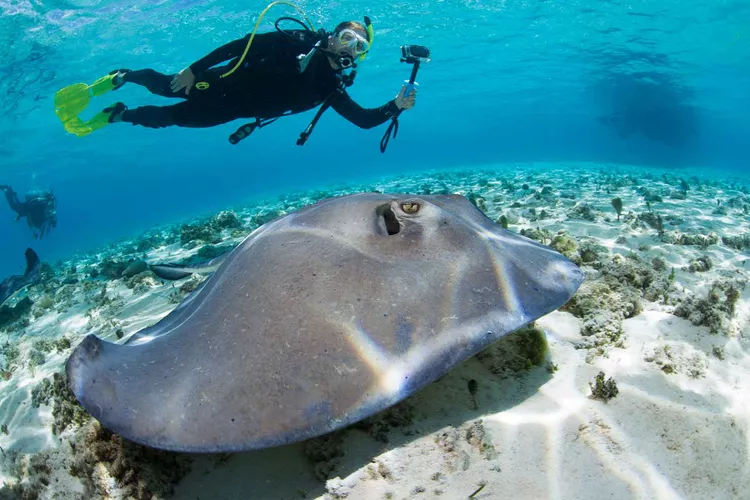Summary
- Moray Eels – Not Dangerous
- Coral – Dangerous If Touched
- Stingrays – Not Dangerous
- Jellyfish – Dangerous but Rare
- Lobsters and Crabs – Not Dangerous
- Sharks – Not Dangerous Unless You Feed Them
- Damselfish – Aggressive, but Not Dangerous
- Sea Urchins – Dangerous to Touch
- Triggerfish – Dangerous
- Remoras – Annoying but Not Dangerous
- Barracuda – Generally Not Dangerous
- Lionfish – Dangerous to Touch
- Humans – Dangerous
Sea animals and fish often suffer from poor reputations. Documentaries display sensational titles like “Killer Squid” or “The Deadliest Octopus,” which often intimidate new divers. Understanding marine animal behavior is essential, as many creatures appear threatening but are not aggressive. Conversely, some seemingly harmless animals can be quite dangerous.
Most injuries resulting from aquatic life are defensive reactions. Therefore, divers should avoid provoking creatures—for example, don’t attempt to pull eels from their habitats or poke lobsters. Generally, if you don’t disrupt them, they won’t disrupt you.
1. Moray Eels – Not Dangerous

Moray eels, commonly found under ledges or within the reef, can intimidate new divers due to their sharp teeth and apparent aggression. However, this behavior serves as a natural way for the eel to filter water over its gills. Their poor eyesight makes them prone to mistaking appendages for prey, so giving them space ensures safety.
2. Coral – Dangerous If Touched

Coral injuries are among the most common scuba diving mishaps. Contacting coral can result in scraping against sharp limestone or stings from coral polyps. Divers can avoid these injuries one hundred percent by maintaining excellent buoyancy and staying aware of their surroundings. Furthermore, touching coral is harmful not just to the diver but also to the reef ecosystems.
3. Stingrays – Not Dangerous

Though stingrays possess sharp stingers, they are not aggressive creatures. Generally, they bury themselves in sand and search for food calmly. When divers approach, most stingrays either remain still or swim away as a means to evade potential threats. They will only sting if they feel threatened or cornered.
4. Jellyfish – Dangerous but Rare

Jellyfish stings can pose a threat; however, such incidents are uncommon as jellyfish do not actively attack. The challenge lies in their nearly transparent tentacles, which are often difficult for divers to see. Before diving, it’s advisable to consult local divers about jellyfish hazards and consider wearing protection to prevent stings.
5. Lobsters and Crabs – Not Dangerous

Lobsters and crabs hold powerful claws primarily for capturing prey and defense, not for pinching divers. If a diver maintains a respectful distance and does not attempt to catch them, encounters with these creatures often yield no issues.
6. Sharks – Not Dangerous Unless You Feed Them

Sharks are often misconstrued as perilous predators. Although they are curious by nature, divers are not their typical prey. Aggressive behaviors usually emerge when divers feed these creatures; thus, it’s essential to refrain from such actions when diving.
7. Damselfish – Aggressive, but Not Dangerous

Damselfish, small and colorful, are territorial and may nip at divers who encroach on their space. This behavior, while aggressive, is unlikely to result in significant harm.
8. Sea Urchins – Dangerous to Touch

While sea urchins are ordinarily nonthreatening to cautious divers, losing awareness can lead to accidental contact with these spiny creatures. Their sharp spines can penetrate skin and some species inflict painful venom upon contact. Consequently, divers should remain mindful.
9. Triggerfish – Dangerous

Some triggerfish species are known for their aggression, particularly the Titan Triggerfish found in the Indo-Pacific Ocean. Their size and powerful jaws can inflict substantial injuries on divers. Proper identification and awareness are essential for maintaining safety in areas known for these fish.
10. Remoras – Annoying but Not Dangerous

Remoras, often sticking to larger marine creatures, can become bothersome to divers. They attach themselves and sometimes scrape against divers’ skin when trying to latch on. Wearing a wetsuit can mitigate these annoyances.
11. Barracuda – Generally Not Dangerous

Barracuda are often perceived as dangerous due to their appearance; however, actual attacks on divers are exceedingly rare. Defensive actions usually result from previous interactions with spearfishing or feeding. To minimize risks, divers should leave valuables on land and avoid provoking barracuda.
12. Lionfish – Dangerous to Touch

Notable for their stunning appearance, lionfish possess venomous spines that can cause excruciating pain. Accidental contact is common, particularly as divers work to control their population. Proper caution around these beautiful creatures is crucial to avoid painful stings.
13. Humans – Dangerous

Perhaps the greatest danger to divers comes from their own actions. Injuries often result from neglecting safety protocols or mishandling equipment. Therefore, it’s critical to respect marine life and keep a safe distance to avoid provoking any danger.





